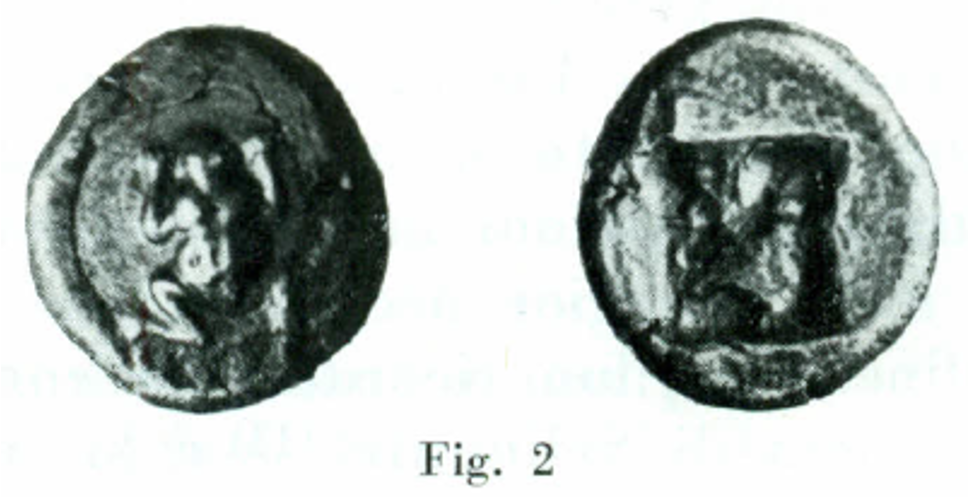SO 1490 - Seriphos (didrachm) over Aegina (Rago 1962, 2)
From SILVER
m (Sonia Hanczack moved page SO 1490 - Seriphos over Aegina to SO 1490 - Seriphos (didrachm) over Aegina (Rago 1962, 2)) |
|||
| Line 1: | Line 1: | ||
{{Overstrike | {{Overstrike | ||
| + | |Image overstriking coin=SO_1490_-_Seriphos_(didrachm).png | ||
|Obverse description=Frog. | |Obverse description=Frog. | ||
| − | |Reverse description=Incuse square. | + | |Reverse description=Incuse square divided into five parts. |
|Mint=Seriphos | |Mint=Seriphos | ||
|Ancient region=Cyclades (Seriphos) | |Ancient region=Cyclades (Seriphos) | ||
| − | |Date from= | + | |Date from=530 |
|Date to=525 | |Date to=525 | ||
| + | |Period=Classical | ||
| + | |Metal=Silver | ||
|Weight=11.65 | |Weight=11.65 | ||
|Diameter=23 | |Diameter=23 | ||
|Denomination=didrachm | |Denomination=didrachm | ||
|Standard=Aeginetic | |Standard=Aeginetic | ||
| − | |Coin reference= | + | |Coin reference=Rago 1962, p. 5-12 (fig. 2) |
| − | |Coin series reference= | + | |Coin series reference=Sheedy 2006, p. 175-176, n° 1-15 ; HGC 6, n° 682 |
| + | |Coin series web reference=https://greekcoinage.org/iris/id/seriphos_sheedy_2006_a | ||
|Overstruck mint=Aegina | |Overstruck mint=Aegina | ||
|Overstruck ancient region=Aegina | |Overstruck ancient region=Aegina | ||
}} | }} | ||
Revision as of 17:30, 12 July 2023
530 - 525
Location/history
Overstriking coin
Description
| ObverseInscription or printing placed on the obverse.: | Frog. | ReverseInscription or printing placed on the reverse.: | Incuse square divided into five parts. |
Mint and issuing power
| MintIdentifies the place of manufacture or issue of a numismatic object.: | Seriphos | Ancient regionAncient region. | Cyclades (Seriphos) | Modern countryModern country: Greece | AuthorityIdentifies the issuing power. The authority can be "pretended" when the name or the portrait of X is on the coin but he/she was not the issuing power. It can also be "uncertain" when there is no mention of X on the coin but he/she was the issuing power according to the historical sources: |
Chronology
| FromIdentifies the initial date in a range assigned in a numismatic context. 530 toIdentifies the final date in a range assigned in a numismatic context.. 525 | Classical 480-323 BC |
Physical description
| MetalThe physical material (usually metal) from which an object is made.: Silver |
WeightWeight of the numismatic object (in grams). in grams: 11.6511.65 g <br />11,650 mg <br /> | DenominationTerm indicating the value of a numismatic object. Examples: tetradrachm, chalkous, denarius.: didrachm |
|
| DiameterDescribes diameter of an object (in mm).: 2323 mm <br />2.3 cm <br /> | StandardStandard.: Aeginetic | ||
References
| Coin referenceReference of the Coin: | Rago 1962, p. 5-12 (fig. 2) | Coin series referenceReference to coin series study: | Sheedy 20061Sheedy 2006, p. 175-176, n° 1-15, HGC 62HGC 6, n° 682 |
| Coin series web referenceCoin series web references: | |||
Overstruck type
Description
| ObverseInscription or printing placed on the obverse.: | ReverseInscription or printing placed on the reverse.: |
Mint and issuing power
| MintIdentifies the place of manufacture or issue of a numismatic object. ᵖ: | Aegina | Ancient regionAncient region. ᵖ | Aegina | Modern countryModern country: Greece | AuthorityIdentifies the authority in whose name (explicitly or implicitly) a numismatic object was issued. ᵖ: |
Chronology
| FromIdentifies the initial date in a range assigned in a numismatic context. toIdentifies the final date in a range assigned in a numismatic context.. | periodTime period of the numismatic object. |
Physical description
References
| Coin type referenceReference to coin series study ᵖ: |
Additional data
| Frequency of overstrikesFrequency of overstrikes: | Level of confidenceLevel of confidence of the identification: | ||
| RemarksRemarks: | |||
References
- ^ Sheedy, Kenneth A. (2006), The Archaic and Early Classical Coinages of the Cyclades, RNS Spec. Publ. 40, London, viii, 261 p., 20 pl.
- ^ Hoover, Oliver D. (2010), The Handbook of Greek Coinage Series, volume 6 : handbook of coins of the islands: Adriatic, Iionian, Thracian, Aegean, and Carpathian seas (excluding Crete and Cyprus), sixth to first centuries BC, Lancaster, 358 p.
